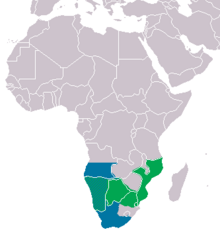Angolan coral snake
| Cape coral snake | |
|---|---|
 |
|
| Cape coral snake | |
| Scientific classification | |
| Kingdom: | Animalia |
| Phylum: | Chordata |
| Class: | Reptilia |
| Order: | Squamata |
| Suborder: | Serpentes |
| Family: | Elapidae |
| Genus: | Aspidelaps |
| Species: | A. lubricus |
| Binomial name | |
|
Aspidelaps lubricus (Laurenti, 1768) |
|
 |
|
| blue – range of A. lubricus green – range of A. scutatus |
|
The Cape coral snake (Aspidelaps lubricus), also known as the Cape coral cobra is a species of venomous elapid snake found in parts of southern Africa. This snake is found in regions of the Karoo, former Cape Province, and all the way up into Namibia. It mostly inhabits very arid regions, like deserts and rocky/sandy ecosystems. These areas within South Africa within the Karoo are known for low predictable rainfall and little vegetation, mostly shrubs and scrubs.
Relatively small, slender bodied snake, around 1.6–2.0 feet long with some growing up to 2.5 feet in some cases. The snake is a small elapid, which means that it is a part of a group of venomous snakes that are usually found within tropical or sub-tropical regions around the globe. Along with its venom, the snake has an enlarged rostral scale, which is the scale located at the front of the snout above the mouth opening on the snake. The snakes head relative to its body is very short, making it very easy to distinguish it from the neck and rest of snake. The snake ranges in colors from red-orange to yellow, slightly resembling the coloration patterns seen on some species of corn snakes. The coral snake also contains thick black bars along the length of the body, fully encircling on the body while not fully on the tail segment. There are around 20–47 total bands spanning the length of the snakes body. This species also contains a narrow hood right below the head, similar to that of a cobra.
This species of snake is nocturnal, which means most of its activity and hunting occurs during the night. Since the snake generally prefers arid, rocky/sandy ecosystems, the snake will often be found living under rocks or even in underground burrows and tunnels. This snake has also been known to prefer leaving its burrow or hiding spots on cooler nights compared to the warmer nights in the summer.
Since the snake is nocturnal, it relies on smell and taste to hunt its prey. This snake typically leaves its burrow or hole in search of smaller vertebrates nearby. It preys specifically on lizards, but has also been known to hunt vertebrates such as legless skinks, small rodents and sometimes other snakes. The snake is also known to target those vertebrates who are strictly diurnal, who are sleeping when it is on the hunt. This snake is known to rear up towards prey or when threatened and then strikes, injecting its venom. In captivity, these snakes are known to eat some types of fish, mice, small rats and also chicken legs, which are preferred by the juveniles.
...
Wikipedia
